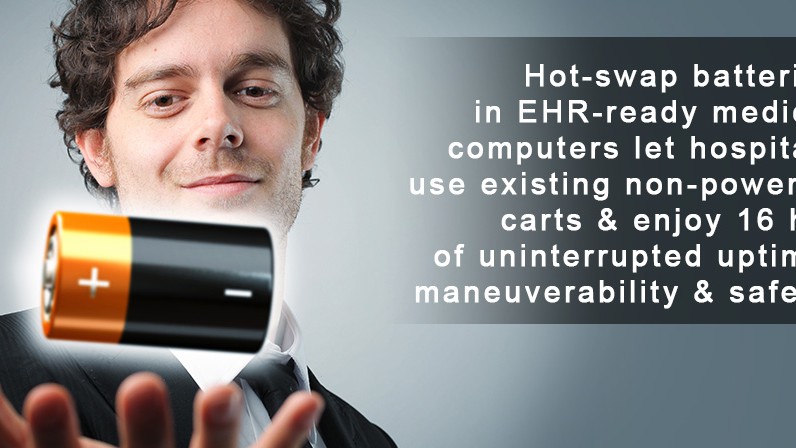It’s not surprising the healthcare industry requires a lot of specialized equipment. Many of the tasks performed like surgery are unique. That’s why medical computers, for example, are used instead of off-the-shelf brands. Features like medical grade and fanless ensure they’re able to handle the demands common in clinics and hospitals, many of which would quickly wear out commercial PCs.
Medical carts play vital roles in healthcare. Your Surgical Department relies on a specific one – anesthesia cart – in making each operation a success. If you’ve been tasked to purchase one for the department, we provide some guidance today in your decision-making, such as:
- How items will be organized in
- Being battery-powered
- What features to keep the contents secure
What Is a Procedure Cart?
Article Guide
Anesthesia carts are part of a group of specialized medical carts called procedural mobile medical carts. Anesthesia carts, as the name suggests, are used by medical staff in the performance of a specific procedure, namely surgery in the operating room.
When shopping for an anesthesia cart, consider the following three factors when choosing the right one for your facility: organization, power, and security.
What is in an Anesthesia Cart and How to Organize It
Unsurprisingly, anesthesia carts provide anesthesia supplies to the OR and/or similar departments. These range from medications to the equipment administering them (example: syringes).
The carts need to be fully stocked before every operation and/or procedure. A spare self-inflating bag, endotracheal tubes, laryngeal mask airways (LMAs), suction catheters, IV supplies, laryngoscope handles and blades, and a variety of meds are just a small sampling of items found in many anesthesia carts.
It’s important that your cart has the right amount of space available to store all these items. Start with the drawers. Do you have enough? And if so, are they the right size? A drawer primarily to be used to hold pill bottles and the like is going to be quite different than that used to store primarily dressings.
Now look to customize your medical cart and adapt it to meet your hospital’s or healthcare facility’s specific needs. This can be done by looking into additional subdivided trays, dividers, shelves, as well as clear tilt bins and even a worktop surface.
Consider how everything in the cart is accessed by the medical staff. How easy are certain medications to get? Are the right pressure cuffs within easy reach? A disorganized cart could potentially put patients at risk. Think if the provider can’t find the right equipment or medication as the patient begins to Code Blue, for instance.
The most commonly used items shouldn’t be out of reach at the back of the bottommost drawer. Label things so everyone knows what’s in what tray or shelf, and where it is.
Speaking of “where”, don’t forget the cart’s location. Don’t store a pediatric oxygen mask in it when the cart’s for geriatric surgical use. Space is valuable on an anesthesia cart, and only the most relevant items should be stored in it.
Advantages of Anesthesia Carts with Battery Power
Consider adding portable batteries to your anesthesia cart. In today’s hospitals, workstations on wheels, general medical carts, and procedural mobile medical carts are used to power peripherals like keyboards and a mouse. For anesthesia carts used in the OR, this makes it easy to access patients’ EMR information and the anesthesia record without compromising safety thanks to features like medical grade and fanless design.
So consider any and all power needs for your anesthesia cart. Many manufacturers can customize their carts so battery packs take up minimal amounts of space.
How Workspace Maximizes Anesthesia Cart Efficiency
While medical computers and even medical tablets have reduced the need for flat surfaces, they’re still necessary like when a nurse, for example, needs to prep and administer anesthesia effectively.
So consider an anesthesia cart with shelves on the side that can be pulled out. This provides an extra workspace to work with. Side pods that swing out for added workspace are another example. Afterwards both can be repositioned back with the shelves reusable for storage.
Floor space too tight for the makeshift workspace? Add an overbridge. This pole or frame allows you to hang items instead of laying them out flat on a surface. Hook up extra shelves, tilt out bins, and accessory rails to hold items like tape and glove boxes. This makes them all within easy reach on the anesthesia cart.
Securing Anesthesia Cart Security Through RFID, Touchpad
Many controlled substances, such as Schedule II, III, IV, and V drugs, are typically stored in anesthesia carts. Choose one that offers card access and a touchpad-operated security that makes use of pin codes. This helps offer maximum security by allowing only authorized personnel to unlock the cart.
Card access is done through RFID cards. When the provider or other medical staff member, like a nurse, needs access to the cart’s contents, they present their card to the built-in reader. The system verifies their identity and permissions via a security program like Imprivata. The drawer or other appropriate container opens if the card-holder has been authorized for access. A record of the card-holder, the drug or drugs taken, and a time-stamp are all recorded in the cart’s medical box PC or similar system. This makes it easier in cases of the audit trail due to possible drug diversion as well as making it easier to update the cart’s settings.
Touchpad-operated security systems require numeric codes or sequences to be entered via an electronic keypad. Many anesthesia carts require both RFID and touchpad as primary and secondary credentials to minimize risks of unauthorized access to the cart’s contents.
Other security features to consider include wi-fi capable, keyless access with auto-relock, and programmable timers.
Closing Thoughts
An anesthesia cart is a form of medical cart. It’s an important part of healthcare especially in the OR, housing drugs, medications, and instruments vital to a patient’s success from surgery. Selection of the right cart is important, and top consideration should be given to cart organization, power options like batteries, and security.
Contact an expert at Cybernet if you’re looking to find the right mix of features for your healthcare facilities’ anesthesia carts including usage with medical computers.
How to Select the Right Medical Cart for Your Facility
March 5, 2015
Medical carts are the most frequently used equipment in hospitals and healthcare units. When purchasing medical carts for your facility, there are a number of things you’ll want to consider to ensure that the purchase…
0 Comments3 Minutes
4 Strategies for Making the Most Out of Your Medical Cart Computers
May 30, 2019
Medical cart computers have been around for a while, but their saturation in hospitals has never been higher than it is now. Sometimes called COWs (computers on wheels), cart computers have increased connectivity,…
0 Comments8 Minutes
Benefits of Cart-Mount PCs with Hot-Swap Batteries in Healthcare
January 28, 2017
The medical technology evolves in giant leaps. At the same time, tight budgets, increasingly stringent regulations and high patient expectations force hospitals to screen their acquisitions ever-more carefully. With so…
0 Comments8 Minutes
You Can't
Learn from a Pop-up
But we can deliver knowledge to your inbox!
We dive deep in the industry looking for new trends, technology, news, and updates. We're happy to share them with you.
Knowledge, News, and Industry Updates Right in Your Inbox





